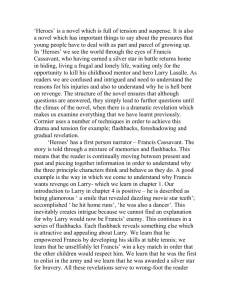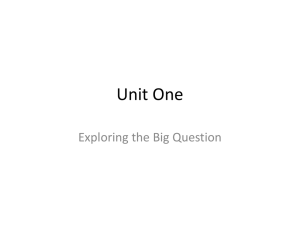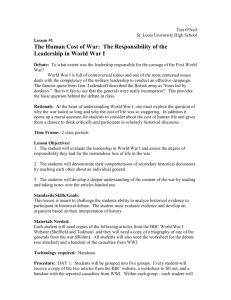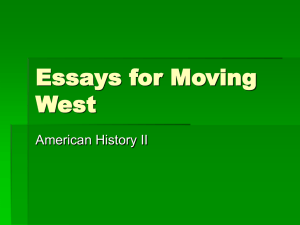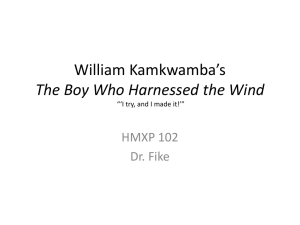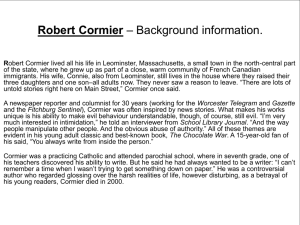Heroes Key Themes - Cardiff High School
advertisement
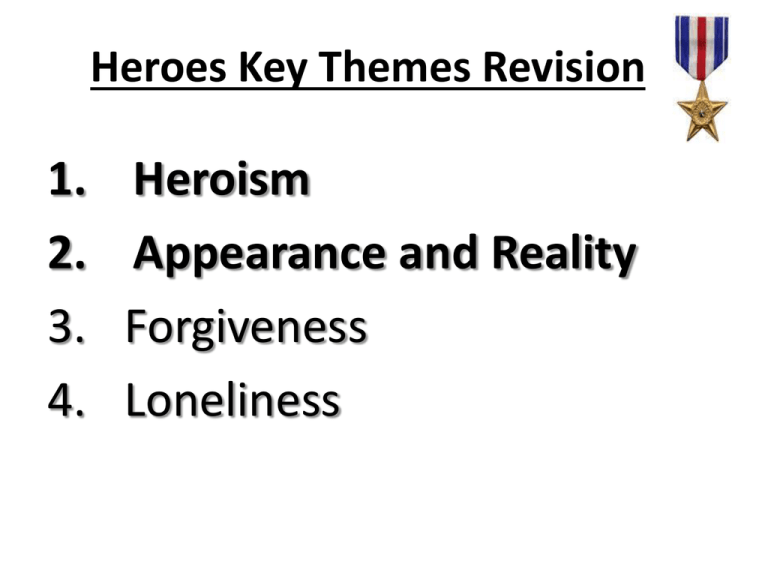
Heroes Key Themes Revision 1. 2. 3. 4. Heroism Appearance and Reality Forgiveness Loneliness Heroism – Introduction The theme of heroism runs through the whole of the book. But the nature of heroism remains unclear. Is Francis the character who shows real heroism? Is it Larry? Or Nicole? Or is it Enrico? Or Arthur? Nowhere in the book does any character find comfort or happiness in their heroism. Picking out key details – Planning! 1. Propaganda newsreels portrays soldiers as heroes. 2. Francis shows great admiration for Larry who is presented as a stereotypical war hero. 3. Francis reflects on war and the idea of heroism as a lie. 4. Mrs Belander, Arthur Rivier and Larry LaSalle show us that perceived heroes are in fact victims 1. War heroes are portrayed as role models worthy of admiration in the book. Cheers and applause fill the cinema when Larry LaSalle features on the Movietone News after his award of a Silver Star Francis: ‘I was impatient to reach the age when I could join them in that great crusade for freedom.’ bravery and patriotism 2. Francis admires Larry who is described as a stereotypical hero. He is presented as an inspirational figure just like when he is working in the Wreck Centre Francis: ‘I could picture him storming a hillside in Guadalcanal, rifle in hand, bayonet fixed, grenades dangling from his belt, pumping bullets into the enemy.’ Language point - Strong verb choices reflect the aggression war, but also foreshadow a darker side to Larry and this is evident in his relationship with Nicole. 3. War heroes are portrayed as victims in the novel. Francis: ‘Nothing glamorous like the write-ups in the papers or the newsreels. We weren’t heroes. We were only there.’ 4. War heroes are portrayed as victims in the novel and are unable to return to normal life. Mrs Belander’s face ‘softened’ and she calls him ‘poor boy’ when she meets Francis because of his injuries. Arthur Rivier is surprised that Francis, a war hero with a Silver Star, should wish to remain anonymous. Francis himself does not see himself as a hero because of his hidden motive for joining up. It is noticeable that Larry welcomes the adulation of others and is happy to be a very public hero, however, he is fragile at the end – ‘pale, eyes sunk into their sockets’ Examiner’s tip Think about how, in the novel, other people admire heroes but heroes do not seem to admire themselves. As a result there are different attitudes to heroism in the novel. Perhaps Robert Cormier wants his readers to consider whether Larry LaSalle is an anti-hero, someone who may carry out acts of bravery and heroism but also has unattractive and destructive qualities. Should a person like that be regarded as a hero? Appearance and reality – Introduction The people in Frenchtown see a sanitised version of glory and heroism in the cinema. They are proud of the contribution they can make to a war which is taking place such a long way away. However, the survivors bring back with them the reality of their wartime experiences and are unable to function. Picking out key details – Planning! 1. In the veterans’ club Arthur Rivier hides his depression after the war. 2. Enrico Rucelli hides his despair behind a mask of humorous remarks. 3. Francis goes to great lengths to hide his identity on his return to Frenchtown. 4. The theme of hidden identity is exemplified in the character of Larry LaSalle, about whom there have been rumours since his first appearance in Frenchtown. 5. Nicole hides the attack from her family in order to spare them pain. 3. Writing about Francis • The white silk scarf and the Red Sox cap that Francis wears serve not only to protect people from being distressed by his terrible injuries, but also to prevent them from recognising him: ‘I have no face’ • His desire to avoid recognition has a practical purpose as he does not wish to be recognised before he kills Larry LaSalle: ‘I feel like a spy’ • However, his disguise is also a symbol of his shame, the shame that he carries everywhere with him and which haunts him when actually his act of bravery was motivated by the selfish desire to be killed 4. Writing about Larry • We quickly become suspicious that Larry has a darker side in the novel as ‘rumours’ spread which suggest an unsavoury past and foreshadow later events • Cormier tells us that the children ‘knew little about him and he discouraged questions’ • Too many, however, still an idol and viewed as a ‘champion’ • Reality confirmed at the end ‘If I want one thing, it would be to have you look at me again the way you did at the Wreck Centre’ Final tips! 1. Describing and explaining characters personalities 2. Understanding the links between the themes and characters 3. Use quotations that matches your point 4. Identify and explore language techniques 5. Interpreting the messages within the story and writer’s intentions 6. Aim to write at least 4 PEE+ paragraphs that show your understanding of the whole text
